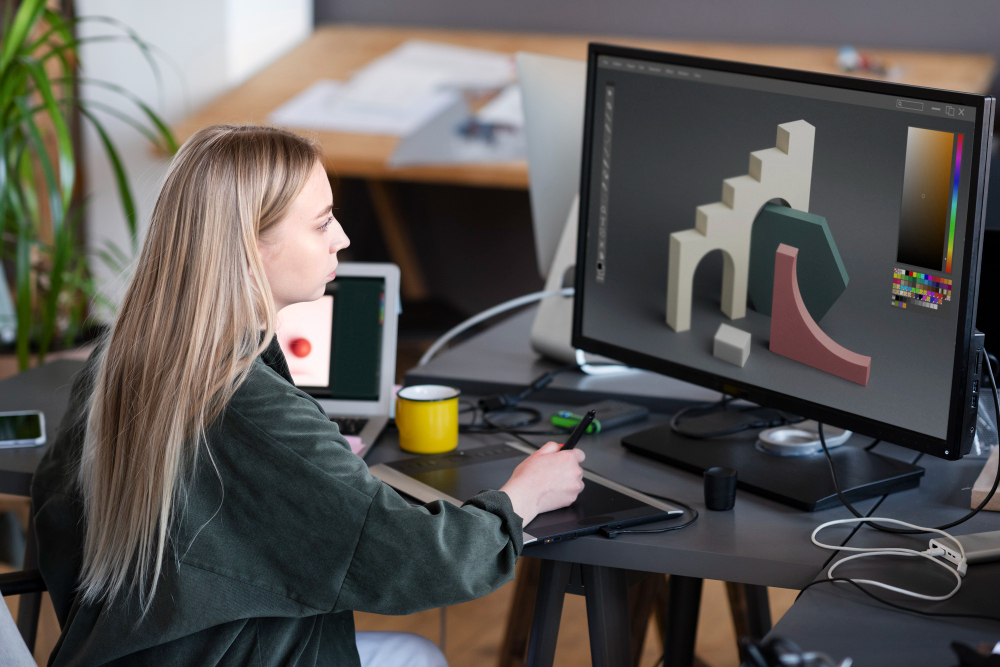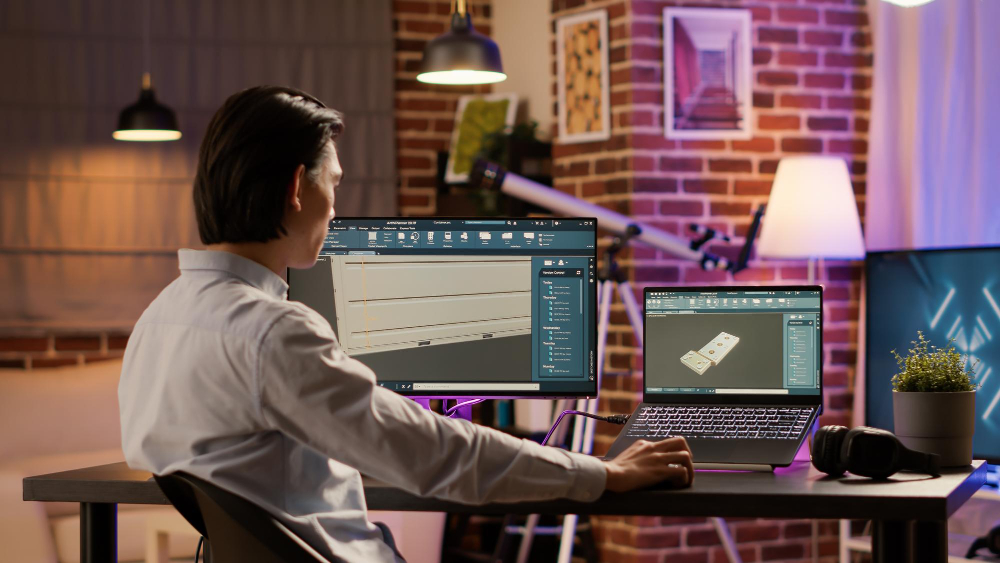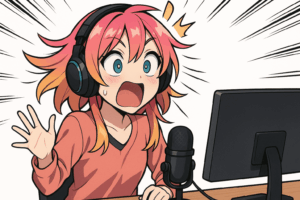Low Poly Models refer to 3D models that have a relatively low number of polygons, resulting in a simplified and stylized appearance. The term “low poly” is derived from the reduced polygon count, which distinguishes these models from their high-poly counterparts. Low poly model creators have gained popularity for their advantages, contributing to a distinct and stylized look that is often favored in various artistic and design contexts.
Low poly model creators are popular for their simplicity, versatility, and accessibility. These user-friendly tools enable easy crafting of visually appealing 3D models with reduced polygon complexity, finding applications in gaming, virtual reality, and artistic contexts. Online low poly model creators like 3Daily have democratized 3D modeling, fostering a vibrant community of creators who share and collaborate. Their rising popularity is attributed to making 3D design accessible and visually compelling for a diverse user base.
Understanding Low Poly Models
Understanding the fundamentals of 3D modeling is crucial to understanding low poly 3D models. 3D modeling is the process of creating virtual objects with specialized software. This involves experimenting with faces, edges, and vertices to create a 3D representation. The low poly style originated from the way low poly model creators used their knowledge of 3D modeling tools to build objects with fewer polygons.
Characteristics Of Low Poly Models
In the world of 3D graphics, Low Poly Models are distinguished by certain features. The characteristics of Low Poly 3D Models are distinctive and contribute to their unique visual appeal. Here are key features that define these models:
1. Simplicity of Low Poly Models:
Firstly, low Poly Models are characterized by their simplified geometry, achieved through a reduced number of polygons. This simplicity contributes to a clean and uncluttered appearance, distinguishing them from more complex high-poly counterparts. The straightforward nature of low poly design not only enhances the model’s visual clarity but also facilitates faster rendering times, making them particularly well-suited for applications where swift real-time performance is paramount, such as in gaming and virtual reality experiences.
2. Efficiency of Low Poly Models:
One of the primary purposes of creating low poly assets is to optimize resource usage, especially in real-time applications like video games and simulations. The reduced polygon count enhances computational efficiency, allowing for smoother performance on a variety of devices. This streamlined efficiency not only improves the overall user experience by preventing lag and delays but also makes low poly models an ideal choice for platforms with varying processing capabilities, ensuring a broader reach and accessibility for diverse audiences.
3. Stylized Aesthetics:
Additionally, low Poly Models often embrace a stylized and artistic aesthetic. The intentional use of basic shapes and limited details results in a visually appealing and easily recognizable style that has become popular in various design contexts. This distinctive visual style not only imparts a unique identity to the models but also fosters a sense of creativity and individuality, making low poly design a sought-after choice for artists and designers aiming to convey a specific mood or theme in their 3D creations.
4. Quick Rendering:
Due to their lower polygon count, Low Poly Models can be rendered quickly, making them well-suited for applications where real-time rendering is crucial, such as interactive media and virtual reality environments. The swift rendering capabilities of low poly models not only enhance the responsiveness of dynamic content but also contribute to a seamless and immersive user experience, particularly in scenarios where rendering speed directly impacts the interactivity and fluidity of the visual elements.
5. Artistic Expression:
Moreover, while low poly design involves simplification, it also allows for creative expression. Low poly model creators employ artistic techniques to convey character and emotion through the strategic placement of polygons and the use of color and texture. This artistic freedom not only showcases the versatility of low poly modeling but also enables creators to infuse personality and narrative into their models, fostering a visual storytelling aspect that goes beyond mere technical constraints and adds depth to the overall aesthetic appeal.
6. Compatibility of Low Poly Assets:
Furthermore, low poly 3D models and assets are versatile and compatible with a wide range of hardware and software platforms. Their lightweight nature makes them ideal for deployment on devices with varying processing capabilities. This inherent compatibility ensures that low poly models can be seamlessly integrated into diverse applications, from mobile devices to high-end gaming consoles, catering to a broad audience and providing a consistent visual experience across different platforms. This adaptability also underscores the practicality of low poly design in reaching users with varying technological specifications.
7. Ease of Animation:
Lastly, the simplified structure of Low poly 3D models facilitates animation, as the reduced number of vertices and edges makes it easier to manipulate and rig the models for movement. This streamlined structure not only simplifies the technical aspects of animation but also enhances the efficiency of the overall animation process. Low poly design’s inherent ease of manipulation allows animators to focus more on the creative aspects of movement and storytelling, making it a preferred choice for projects where efficient and expressive animation is crucial, such as in game development and animated content production.
Understanding and leveraging these characteristics, Low poly model creators bring a unique blend of technical skill and artistic vision to produce visually striking and efficient 3D assets for diverse applications in the world of digital media and interactive experiences.

Advantages of Using Online Low Poly Model Creators:
The advantages of online low poly model creators extend beyond accessibility and cost-effectiveness, encompassing real-time previews, cross-browser compatibility, community marketplaces, and integrated workflows. These features collectively contribute to a more streamlined, collaborative, and efficient 3D modeling experience for a diverse user base.
1. User-Friendly Interfaces:
Firstly, many online low poly model creators feature user-friendly interfaces that cater to both beginners and experienced designers. Intuitive controls and straightforward tools streamline the modeling process, making it accessible to a broader audience. This emphasis on user-friendliness not only reduces the learning curve for newcomers but also enhances the overall efficiency for experienced designers, allowing them to focus more on the creative aspects of their work rather than navigating complex software interfaces. The intuitive nature of these interfaces fosters a more inclusive environment, empowering a diverse range of users to engage in the process of 3D modeling.
2. Real-Time Preview:
Secondly, online low poly model creators often provide a real-time preview of the model as it is being developed. This immediate feedback allows creators to make instant adjustments, enhancing the overall workflow efficiency and reducing the iteration time. The real-time preview feature serves as a valuable tool for creators to visualize the impact of changes promptly, fostering a dynamic and iterative design process. This not only accelerates the modeling phase but also enables designers to fine-tune their creations with precision, resulting in a more streamlined and responsive development experience.
3. No Version Compatibility Issues:
With traditional software, compatibility issues can arise when sharing files between different versions. Online low poly model creators like 3Daily eliminate this concern as users always have access to the latest version of the tool, ensuring seamless collaboration and file sharing. This eliminates the need for users to manage software updates or worry about version discrepancies, promoting a more efficient and collaborative workflow. The consistent access to the latest features and improvements enhances the user experience, allowing creators to focus on their projects without the hindrance of compatibility concerns that can often arise in traditional software environments.
4. Resource Efficiency of Low Poly Model Creators:
This democratizes 3D modeling, enabling individuals with less powerful devices to participate in the creation process. By leveraging the computational power of online servers, these platforms make 3D modeling more accessible to a wider audience, breaking down barriers related to hardware limitations and ensuring that aspiring designers or hobbyists can engage in the creative process without the need for high-end computing equipment. This approach not only promotes inclusivity in the field but also contributes to a more sustainable and resource-efficient modeling ecosystem.
5. Community Marketplaces:
Moreover, some online low poly model creators integrate community marketplaces where users can buy, sell, or share 3D models. This feature expands the available resources for creators, providing a platform for them to showcase their work or find models that suit their specific project requirements. The inclusion of community marketplaces fosters a collaborative environment, allowing creators to monetize their skills by selling models or discovering assets created by others that complement their projects. This dynamic exchange of resources not only enhances the diversity of available content but also strengthens the sense of community within the platform, encouraging mutual support and the sharing of expertise among 3D model creators.
6. Cross-Browser Compatibility:
Online model creators are designed to work seamlessly across various web browsers, ensuring a consistent experience regardless of the browser preference. This eliminates the need for users to stick to a specific browser to use the tool effectively. The emphasis on cross-browser compatibility promotes flexibility, allowing creators to access and utilize the online model creator from their preferred browser without encountering functionality or performance issues. This inclusive approach accommodates diverse user preferences and reinforces the accessibility of the tool, contributing to a more user-centric and convenient 3D modeling experience.
7. Automatic Updates:
In addition, online tools can automatically update to the latest version without requiring manual intervention from the user. This ensures that creators always have access to the newest features, bug fixes, and improvements without having to actively manage updates. The automatic update mechanism streamlines the user experience, eliminating the need for creators to monitor and initiate updates manually. This feature not only keeps the tool current with industry advancements but also contributes to a more secure and stable environment, allowing users to focus on their creative endeavors without the interruption of manual software maintenance.
8. Subscription Models and Licensing Options:
Furthermore, many online platforms offer subscription-based models or flexible licensing options, allowing users to choose plans that best suit their needs. This pay-as-you-go approach can be advantageous for those who prefer not to make a substantial upfront investment in traditional software licenses. By providing subscription models and flexible licensing, these platforms cater to the diverse financial preferences of users, offering a more cost-effective and scalable solution. This approach enables creators to access the necessary tools without a significant initial financial commitment, making 3D modeling resources more accessible and adaptable to individual budget constraints.
9. Responsive Customer Support:
Online low poly model creators often come with dedicated customer support teams. Users can receive assistance promptly through various channels, including chat support, forums, or email, ensuring that any issues or inquiries are addressed in a timely manner. The availability of responsive customer support enhances the overall user experience, providing a valuable resource for troubleshooting, guidance, and general assistance. This proactive support system not only fosters a sense of reliability and trust, assuring users that help is readily available, but also contributes to a smoother and more enjoyable 3D modeling experience on these online platforms.
10. Cost- Effectiveness of Low poly Model Creators:
Lastly, numerous online low poly model creators provide free low poly models, offering a budget-friendly solution for individuals or small teams. Users can initiate their creative process without incurring upfront costs typically associated with traditional software licenses. This accessibility enhances the affordability of 3D modeling, democratizing the creation process for a broader audience with limited financial resources.

Conclusion
In conclusion, the evolution of low poly models and the advent of online low poly model creators have revolutionized the landscape of 3D graphics, offering a powerful combination of accessibility, efficiency, and creativity. The role of low poly model creators becomes evident in their ability to seamlessly navigate the complexities of 3D modeling, leveraging online platforms to streamline workflows, encourage collaboration through community marketplaces, and also provide responsive support. The advantages of online low poly model creators like 3Daily, including user-friendly interfaces, real-time previews, and automatic updates, further amplify their appeal, making 3D modeling more inclusive and dynamic. Overall, the integration of technology and community-driven features has ushered in a new era of creativity, accessibility, and collaboration in the realm of low poly models.



